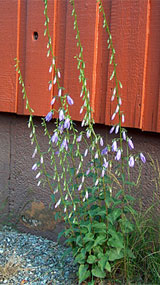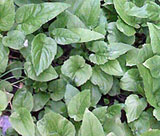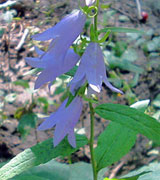Creeping bellflower
Creeping bellflower's pleasing look is often mistaken for a desirable garden plant but is actually quite invasive and can aggressively invade lawns and gardens.
What can I do to stop the spread of creeping bellflower?
- Remove plants as they appear in your yard by digging out as much root as possible.
- Avoid introducing this plant to your yard through wildflower seed mixes and potted plants (ensure purchased Campanula species are NOT C. rapunculoides).
- Dispose of all removed plant parts by bagging and putting directly in the black cart (never compost this species).
What is creeping bellflower?
Plant type: perennial
Size: low growing clumped foliage in spring, grows to 1 m tall flowering spike in early summer
Leaves: heart-shaped in early stage becoming lance-shaped, tooth-edged and coarse textured
Flowers: purple-blue 2-3 cm long nodding bells, blooms begin on lower stem

Once established, creeping bellflower is very difficult to remove as even the smallest tiny root fragments can grow entirely new plants. It also spreads very easily as each stem produces up to 15,000 seeds. Creeping bellflower is also resistant to some herbicides.
Creeping bellflower is also known as garden bluebell, rover bellflower, purple bell, garden harebell, creeping campanula, creeping bluebell.

Alternatives to creeping bellflower
Consider some of these garden selections as alternatives to creeping bellflower:
- Native & ornamental bellflowers (e.g. Carpathian harebell, Campanula carpatica)
- Native & ornamental beardstongues (e.g. Smooth Blue Penstemon, Penstemon nitidus, or Hybrid Beardtongue, Penstemon 'Pink Chablis')
- Blue Mirror Delphinium (Delphinium grandiflorum 'Blue Mirror')

More information
- Learn more about the The City of Calgary's initiatives to prevent invasive plant infestations - Invasive Plants Prevention and Management
- Alberta Invasive Species Council factsheet - Creeping Bellflower
- Alberta Invasive Species Council, Weed Wise Gardening for Alberta brochure

